Preventing and treating common skin conditions in dogs can be difficult, as many of them are caused by external factors such as allergies or health conditions.
Your dog’s diet is crucial to its overall health and can be modified to combat certain skin conditions.It is essential to keep your dog’s vaccinations up-to-date, as they can help prevent some of the most common skin issues. Skin conditions in dogs are fairly common, but they can cause irritation and itching. If you notice your dog scratching too much or licking excessively, it could indicate skin problems.
We’ll discuss preventing and treating common skin conditions in dogs. We’ll tell you what they are, how to spot them, and the treatment options available to help your dog return to normal.

What Are Common Skin Conditions In Dogs?

Common skin conditions in dogs include allergies, bacterial infections, and thyroid disease. Allergic skin conditions in dogs can cause itching, redness, swelling, or skin irritation. They can be temporary or chronic and often affect the face, paws, and ears.
Skin allergies are common in many dog breeds, such as West Highland White Terriers, Wirehaired Fox Terriers, Golden Retrievers, Labrador Retrievers, Lhasa Apsos, Bulldogs, English Setters, Boxers, Dalmatians, and Shar-Peis. Common bacterial skin infections in dogs include ringworm and hot spots. A ringworm fungus causes a skin infection known as ringworm.
It causes itching and redness of the skin. Red patches that may itch or scab but do not heal are hot spots. They are most common in young dogs but can also occur in older dogs. Thyroid disease is not curable, but you can manage it by changing the dog’s diet and administering medications as directed by your veterinarian.
8 Simple Tips For How To Prevent And Treat Common Skin Conditions In Dogs
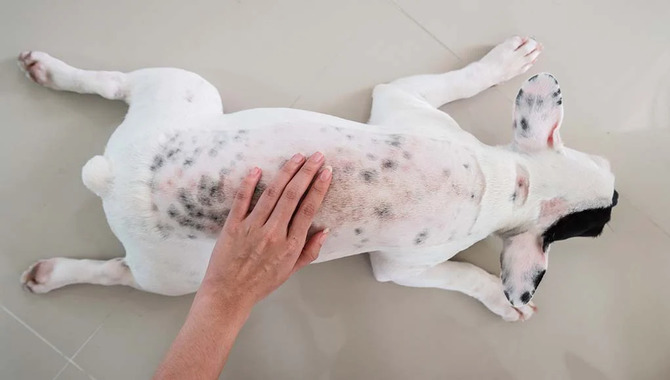
A common skin condition in dogs is skin irritation, which allergies, flea bites, infections, or irritation from chemicals or outdoor activities can cause. Skin irritation can cause redness, itching, swelling, and scabs if left untreated.
To prevent and treat it, it’s important to diagnose the cause of skin irritation early with a physical exam, blood work, and recommended testing. Skin conditions in dogs can be a big cause of concern for many pet owners. They can range from minor and treatable to serious and life-threatening. Here are 8 simple tips for how to prevent and treat common skin conditions in your dog
1. Fleas

Fleas are a common cause of skin problems in dogs. They can foster allergic reactions and itching by biting the skin. They can also cause alopecia, or hair loss, by feeding on the skin. In addition to flea-related skin conditions, fleas can factor in parasites such as sarcoptic mange.
To treat flea-related skin problems, it is important to eliminate and treat all flea populations in your dog’s environment, using a safe flea treatment that will effectively kill both flea adult and larval stages. You may also use flea sprays or powders with safe treatments for your dog’s skin conditions.
2. Ticks

Removing ticks from your dog as soon as possible after spending time outdoors is vital to reduce the risk of disease transmission. Additionally, it’s essential to visually inspect your dog for ticks after spending time outdoors.
If you notice any ticks on your dog, remove them immediately with a pair of fine-tipped tweezers. Additionally, it’s important to know the signs of a tick-borne illness, such as fever, headaches, chills, and muscle aches.
Combining topical medications with natural supplements such as omega-3 fatty acids and biotin is important to prevent and treat common skin conditions in dogs. These supplements can help your dog’s skin health and optimize its coat quality.
3. Dry Skin
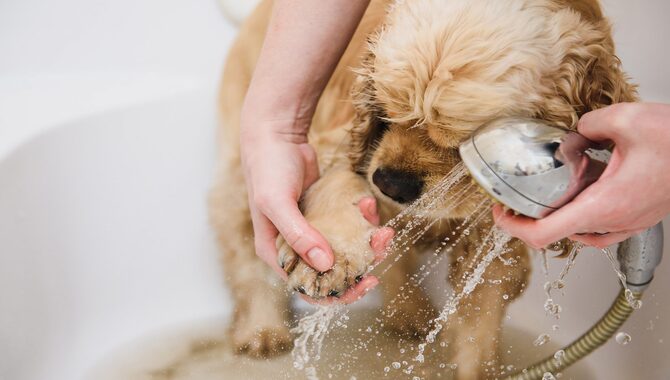
Dogs with dry skin may experience itching and a loss of hair. This skin condition can be caused by a dry environment that results in dry skin. To treat dog skin conditions, it’s important to address the underlying cause, such as a dry coat or over-bathing.
To help dogs stay comfortable in a dry environment, humidifiers can be beneficial. Additionally, special dog shampoos can help restore moisture to the dog’s skin. While dry skin on dogs is not usually a serious health issue, your veterinarian can easily treat it. For more tips on caring for your dog’s skin, please visit our blog at
4. Manage

Mange is a common skin disease in dogs that is caused by mites. You can treat it with topical products and regular bathing. However, it may require more intensive treatment if acquired at home rather than in the veterinarian’s office.
Sarcoptic mange is the most common type, but demodectic mange is not contagious to humans. To prevent and treat mange, it’s important to ensure your dog’s health and well-being, including regularly grooming and providing a clean, parasite-free environment.
Additionally, it’s essential to keep your dog’s bedding clean and dry to prevent flea and mite loads from spreading throughout your home.
5. Hot Spots
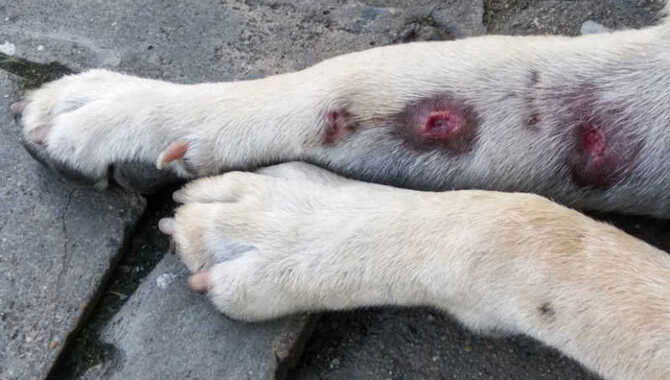
Hot spots are red and inflamed areas of the skin that may be caused by moisture trapped against the skin, allergies, insect bites, and infections. They are common skin conditions that dogs can develop. The treatment for hot spots may include shaving the hair around the area to help dry the skin and topical or oral antibiotics.
Alternatively, it may involve keeping the area clean and dry to reduce the chances of infection. It is always best to seek professional assistance if hot spots do not improve within 48 hours, as they can cause a systemic bacterial skin infection.
To prevent hot spots from occurring in the first place, it’s important to exercise your dog regularly, keep him away from harmful chemicals such as flea treatments, and ensure he is using flea prevention products that are safe for dogs. If you notice your dog developing hot spots or other skin problems, it’s always best to contact your veterinarian immediately for advice and treatment options.
6. Skin Infections

Dogs are known for their ability to get skin infections easily. These infections can cause itching and inflammation of the skin, hair loss in patches, sores that won’t heal, pus nodules, yeast infection, and persistent itching, licking, and biting.
A common skin infection in dogs is ringworm. This infection causes redness and itching of the skin and loss of hair in patches. The infection may be caused by several different types of fungi, including dermatophytes (a fungal plant parasite). And oomycetes (a fungal parasite).
To diagnose skin infections in dogs, taking samples from the skin and examining them under a microscope is important. It’s also common to take a hair or blood sample to determine if the infection is systemic or localized. In most cases, skin infection treatment involves medications designed to kill the bacterial or fungal organisms responsible for the infection. If your dog shows signs of a skin infection, consult your veterinarian as soon as possible.
7. Allergies

Dogs can suffer from allergies, with symptoms such as itching, rashes, hives, and chronic ear infections. Allergen treatment typically involves identifying the cause of the dog’s allergies and managing it to the best of your ability. In some cases, you may require medications to combat itching.
Allergies in dogs can be caused by environmental triggers such as mold or pollen in the air. Nutritional allergies may also play a role. Dogs suffering from allergies require lifelong treatment to prevent future flare-ups and mitigate their symptoms. Although you cannot cure allergies, short-term treatments can help control acute flares and allow your dog to lead a comfortable life.
8. Ringworm
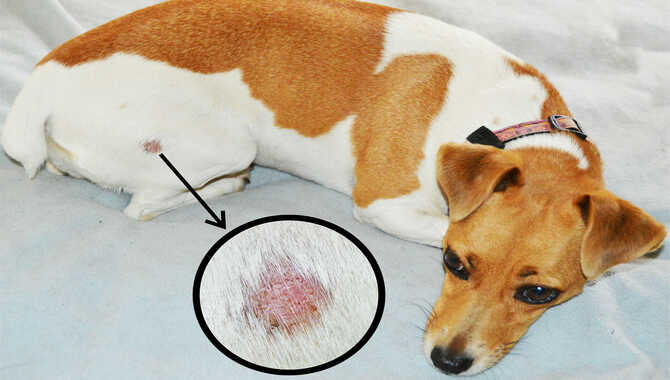
Ringworm is a fungal infection that affects both animals and humans. It is most common in puppies, as their immune system is still developing. The disease can affect dogs’ skin and hair, ears, and tails. Symptoms of ringworm may include hair loss, circular lesions, inflammation, and broken or brittle claws. To prevent ringworm in your dog, separating them from infected objects, animals, and people is important.
When treating ringworm in your dog, it’s important to use a dermatological shampoo to clean the hair gently and avoid damage to the skin. Additionally, you may prescribe topical creams or ointments for treatment. To reduce the risk of ringworm infection in your dog, it’s also recommended to wash all contaminated clothing and bedding immediately after handling your dog.
Symptoms Of Common Dog Skin Conditions
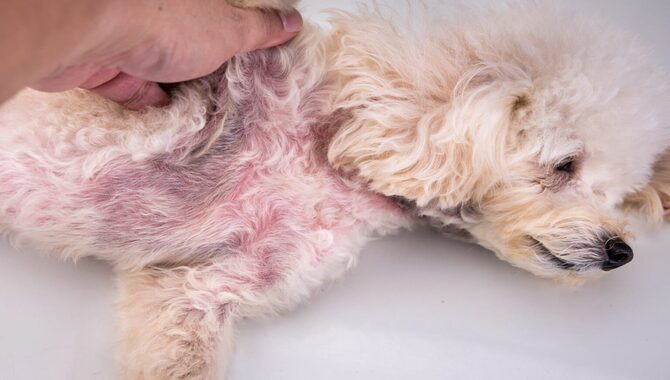
It is essential to know the symptoms of typical dog skin conditions, so you can take steps to help your dog if they develop one. These can include dry, itchy, scaly skin, redness, scaling, and inflammation. Taking action immediately is important if you notice any of these signs in your dog.
You can do several things to help your dog feel better and avoid more serious conditions such as eczema or skin cancer. It is also helpful to see your veterinarian for an evaluation and treatment options if necessary.
Prevention And Treatment For Dog Skin Conditions

To prevent and treat dog skin conditions, your dog needs to be examined by a veterinarian as soon as possible. This will help the veterinarian diagnose the problem and provide the best treatment options for your dog.
Some common dog skin conditions that a veterinarian can treat include hot spots (acute moist dermatitis), flea allergies, skin infections, ringworm, allergies, and stings. Causes of dog skin conditions can vary, but hot spots are often caused by excessive licking of the skin or scratching.
It is common for dogs with thick undercoats to develop hot spots. Oral or topical antibiotics and anti-inflammatory medications can help reduce inflammation and irritation of the skin. In some cases, your veterinarian may prescribe medications such as corticosteroid medications or antihistamines to reduce itching and inflammation. Finally, it is important to regularly clean, groom, and exercise your dog to prevent him from developing skin conditions in the first place.
Conclusion
We have discussed the prevention and treat common skin conditions in dogs treat them. Skin diseases in dogs can be serious, and it is important to take prompt action to treat them properly. Some can even lead to life-threatening consequences if they are not treated on time.
The first step in preventing skin diseases is regular visits to the vet for checkups, which will help detect any problem early on and allow for timely treatment and prevention measures.
The most common skin problems in dogs are infections and allergies. If your dog has a red rash that does not go away or develops sores, contact your veterinarian immediately, as these could be signs of an infection or disease.
It is also important to keep your dog’s diet clean and free of certain substances, such as onion, garlic, grapes, raisins, chocolate, and certain meats, as these can cause allergies and skin issues in dogs. Regular grooming helps maintain healthy skin by removing dead cells and hair that can cause infections. Finally, using moisturizers for dry or itchy skin can help soothe any discomfort your dog might be experiencing.
Frequently Asked Questions
How Do You Prevent Skin Problems In Dogs?
Prevention of skin conditions in dogs largely depends on the owner’s vigilance and the dog’s environment. Proper hygiene, nutrition, and exercise are essential for good health. Regular veterinary checkups can help identify any issues early on.
If you notice any signs of a skin condition in your dog, such as itchiness or redness, take it to the vet immediately. Prevention involves regular preventative care for your dog.
What Is The Most Common Skin Condition In Dogs?
The most common skin condition in dogs is Impetigo. This skin infection is usually found on dogs’ bellies but can also occur on other body parts. Symptoms of Impetigo include pus-filled blisters, crusty areas on the stomach, and lesions. Treatment options for Impetigo include a special medicated shampoo or topical treatment.
How Can I Cure My Dog’s Skin Infection?
Several ways to cure a dog’s skin infection include using oatmeal or oatmeal soap as a shampoo. Try using baking soda and water as a two-step cleaning solution for the affected area. You can also take your dog to the vet for proper treatment.
Sometimes, you may need prescription medications such as antibiotics or antifungal shampoos to cure the problem. Your veterinarian can help you determine the best treatment for your dog’s condition.
What Causes Skin Conditions In Dogs?
There are many possible causes of skin conditions in dogs, all of which can be caused by bacterial infections (such as hot spots, folliculitis, and puppy pyoderma), allergies, parasites, contact dermatitis, ear and skin infections, stress, and boredom. However, scratching, licking, and chewing the affected area most commonly cause hot spots and folliculitis.
Flea bite allergies, food allergies, atopic dermatitis, and moisture trapped in the coat from swimming or bathing can also cause skin conditions in dogs.
How Can I Treat My Dog’s Skin Problem?
There are several potential causes of skin problems in dogs, including allergies, infections, skin tumors, and disc disease. The first step to treating a dog’s skin problem is appropriately identifying and treating the cause. If a skin issue persists or becomes severe,
pursuing additional treatment options such as prescription medication or veterinary surgery may be necessary. Regular checkups and maintenance can help maintain your dog’s health and well-being.

Aquarium passion is all about connecting with the aquatic life and providing education to the public on the importance of these creatures. We showcase a wide variety of marine life through our exhibits as well as working with schools to provide unique learning opportunities for students of all ages.








